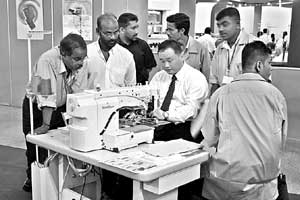
| Rs 600 million apparel industry hub in ‘07 Sri Lanka’s garment industry is to get a Rs 600 million one-stop-shop, apparel industry hub in Katunayake next year. “The facility will be completed in 2007. We have already identified the land and the planning has started. This will be an apparel industry hub that visitors can come to, for one-stop-shop solutions,” said the Minister of Enterprise Development and Investment Promotions, Rohitha Bogollagama, speaking at the inauguration of two apparel industry exhibitions at the Sirimavo Bandaranaike Memorial Exhibition Centre, on Thursday. The proposed apparel industry hub will come under the Board of Investment of Sri Lanka (BOI) and is expected to cost around Rs 600 million to build. “We are hoping to finance this through a public-private partnership,” said the Minister. The facility will be located close to the Katunayake International Airport and the Free Trade Zone. Bogollagama said the new complex will be equipped to host major garment industry exhibitions, as available exhibition infrastructure is inadequate for large scale machinery exhibitions. “I have already noted the constraints to hosting exhibitions in Sri Lanka. So I will see to it that there is a fully fledged exhibition location in the facility in Katunayake,” said the Minister. Meanwhile the government is also looking at expanding textile production, to facilitate vertical integration of the garment industry. “The Kabool lace facility in Pannala, that is now defunct, will also soon be converted into a textile manufacturing zone,” said the Minister. Under the government’s 2006 Budget plans, two textile zones, Thulhiriya and Horana, were initiated this year. The Thulhiriya textile facility that was out of operation since late 2003 was handed over to MAS Holdings, to become Sri Lanka’s first privately managed industrial zone. The government signed another MOU with Brandix Lanka recently to set up a second dedicated textile facility in Horana. Pannala is expected to add to textile manufacturing capacity in Sri Lanka. The government says it has also modified laws to facilitate investments into the garment sector. “We have introduced company law reforms. We have brought in a very futuristic corporate law through the new Company Act of 2006 that allows incorporation of single shareholder companies,” said the Minister. The two apparel industry exhibitions that opened on Thursday are also expected to contribute to industry sustenance by facilitating inflow of technology and fabric. The Apparel Industry Suppliers Exhibition (AISEX) and the Fabric and Accessory Suppliers Exhibition (FASE) are specifically structured to cater to the garment industry. AISEX is aimed at helping garment factories source the best technology to cut costs and increase productivity, while FASE is aimed at providing textiles for the industry. Currently nearly 60 % of the textile requirements of the export garment industry are met through imports. However, garment industry experts say more government support is needed particularly in areas like low cost financing for technology upgrading. “The government needs to re-appraise its textile policy to be in-line with some of our competitors. For example the government of India has launched its Technology Upgrading Fund which supports the industry by providing loans at low interest rates for factories that go in for technology advancement. The government of Pakistan has committed 333 billion Pakistan rupees to upgrade their textile industry,” said the Chairman of the Sri Lanka Apparel Institute, Prof. Lakdas Fernando “In Sri Lanka, it is the SME sector that needs support to upgrade,” said Prof Fernando. Hi-tech latest Juki, the Japanese industrial sewing machine manufacturer, currently Sri Lanka’s market leader in the sector, introduced two of its latest products at the AISEX exhibition. “We have brought the latest automatic pocket welting machine to this exhibition. It was only out this month. This is the first delivery to an Asian country. We have also brought the latest version double-needle lockstitch machine,” said President of Juki Singapore, Matsuda Susumu, attending the exhibition. The US company Tukatech showcased its latest version of “e-fit simulator” that allows manufacturers to design and fit clothing onto virtual models. Tukatech says its latest CAD system removes the need to use physical materials. A final product can be designed, developed and sent to buyers without spending on physical samples. A few Chinese machinery manufacturers were also present offering garment factories a choice of low cost machinery. The Taizhou Hina Company from China for instance, introduced its sewing machine ‘Sus” to Sri Lanka at the exhibition. “Compared with Japanese machines, Chinese machines are very much cheaper. Maybe half the price, but you can reach 70% to 80% quality requirement. So we hope to introduce our machines to Sri Lanka,” said General Manager of Taizhou Hina, Geoffrey Pan. A few regional manufacturers are also looking at the possibility of supplying the local garment industry. India’s largest manufacturer of ‘embellishments’ for garments, Sky Industries Limited, says it entered Sri Lanka through an agent this year and is hoping to carve out a market. “We specialise in narrow, woven fabric like Velcro and velvet tape used in embellishing garments. In India we are the major supplier to the garment industry. We have about 70% of the garment market and almost 100% of the footwear market. So we are looking at a similar situation in Sri Lanka,” said Jank J Mody, Branch manager, Sky Industries. |
| || Front
Page | News
| Editorial
| Columns
| Sports
| Plus
| Financial
Times | International
| Mirror
| TV
Times | Funday
Times | ST
- 1|| |
| |
Copyright
2006 Wijeya
Newspapers Ltd.Colombo. Sri Lanka. |
 The
apparel industry hub is part of the government’s strategy
to support the garment industry in the wake of post quota market
changes and heightened competition.
The
apparel industry hub is part of the government’s strategy
to support the garment industry in the wake of post quota market
changes and heightened competition.